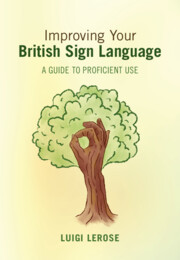Book contents
- Improving Your British Sign Language
- Improving Your British Sign Language
- Copyright page
- Contents
- Figures
- Tables
- Acknowledgements
- 1 Introduction
- 2 Sign Articulation Accuracy
- 3 Use of Signing Space: Pointing, Perspective and Collocation
- 4 Using Constructed Action and Depiction as Part of the Creative Lexicon
- 5 Conclusion and Further Exercises
- References
- Index
4 - Using Constructed Action and Depiction as Part of the Creative Lexicon
Published online by Cambridge University Press: 02 January 2025
- Improving Your British Sign Language
- Improving Your British Sign Language
- Copyright page
- Contents
- Figures
- Tables
- Acknowledgements
- 1 Introduction
- 2 Sign Articulation Accuracy
- 3 Use of Signing Space: Pointing, Perspective and Collocation
- 4 Using Constructed Action and Depiction as Part of the Creative Lexicon
- 5 Conclusion and Further Exercises
- References
- Index
Summary
This chapter introduces the concepts of constructed action and depiction, and explains how they are important aspects of the creative lexicon in BSL. A description of how the creative lexicon is used is provided in Section 4.1, along with an explanation of how the creative use of bodily and facial movements to represent actions or events in discourse can be achieved in a dynamic and engaging way. This section also provides an understanding of how classifier signs can aid the learner in producing more creative and visual sign articulations. In Section 4.2, common mistakes when using the creative lexicon are presented, such as errors in expressing size and proportion and misuse of eye gaze during constructed dialogues, along with strategies for preventing such mistakes. The productive elements of the creative lexicon are encouraged in the last section of this chapter, Section 4.3, which contains exercises that will help you to improve your sign articulation in this area.
Keywords
- Type
- Chapter
- Information
- Improving Your British Sign LanguageA Guide to Proficient Use, pp. 135 - 195Publisher: Cambridge University PressPrint publication year: 2025

